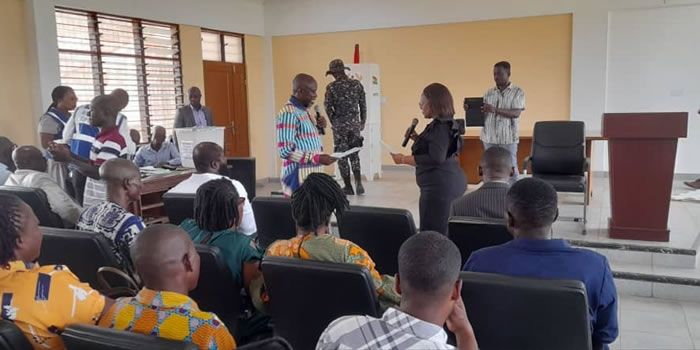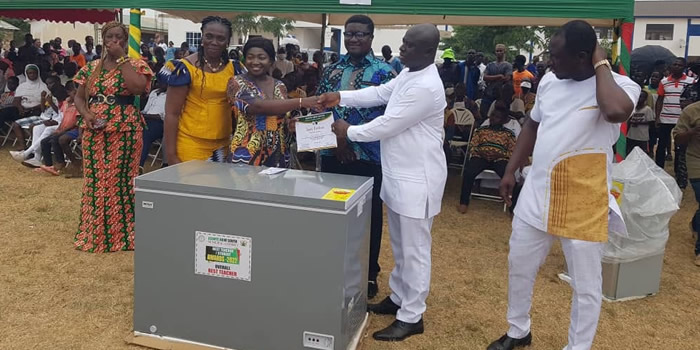

The District Assembly
The current local government system has a three (3) tier structure at the district level, which is made up of the District Assembly, the Town/Area Councils and Unit Committees. Established in 1988 by a Legislative Instrument, L.I. 1409, the Asante Akim South Munincipal Assembly, as the highest political, administrative and planning authority, has responsibility for the overall development of the district. It therefore formulates plans for effective resource mobilization and undertakes development projects and programmes annually.
It is made up of a District Chief Executive, and sixty (60) members , forty-two (42) elected members from the electoral areas, eighteen (18) members appointed by the President in consultation with chiefs and interest groups in the district, and one Member of Parliament who has no voting right. The Presiding Member, who is elected from among the Assembly members, convenes and presides over the meetings of the Assembly. Election of Women to the Assembly has increased from 2 to 5 (5%-12%). Total membership of Women Assembly members has increased from 10-14.
Working up to the District Assembly are the two (2) Town Councils at Juaso and Obogu; nine (9) Area Councils at Asankare, Banka, Banso, Bompata, Dwendwenase, Komeso, Morso, Nnadieso and ofase ; and 95 Unit Committees.
The Assembly performs its functions through the Executive Committee and a network of Sub-Committees. The Executive Committee exercises executive and administrative functions of the Assembly while the Sub-Committees collate and deliberate on issues relevant to their functional areas. It has twenty-one (21) members. The Executive Committee has the following Sub-Committee:
i. Development Planning Sub-Committee
ii. Social Services Sub-Committee on Education
iii. Social Services Sub-Committee on Health
iv. Works Sub-Committee
v. Justice and Security Sub-Committee
vi. Finance and Administration Sub-Committee
There is also the Public Relations and Complaints Committee chaired by the Presiding Member, Agricultural sub-committee and Investment and Trade sub-committee and Audit Implementation Committee the Committee. The District Assembly is the highest governing body in the District and exercises its executive and administrative functions through the Executive Committee, which is chaired by the District Chief Executive.
For administrative effectiveness, the District Chief Executive (DCE) is supported by a secretariat or the Central Administration referred to as the office of the District Assembly, which is headed by a District Co-ordinating Director (DCD) who reports to the District Chief Executive and is in charge of the day-to-day administration of the Assembly. The District Co-ordinating Director is also in charge of all Heads of Decentralised Departments in the District
In addition to the Central Administration Department (District Co-ordinating Directorate), the following Decentralized Departments and Public Agencies exist in the district:
- Ghana Education Service
- Non-formal Education Division
- Ghana Health Service
- Department of Community Development
- Department of Social Welfare
- Department of Food and Agriculture
- Forest Services Division
- Controller and Accountant-General’s Department
- Town and Country Planning Department
- Public Works Department
- Information Service Department
- Ghana Statistical Service
- Births and Deaths Registry
- Department of Feeder Roads
- Department of Parks and Gardens
- Ghana Post
- Department of Co-operatives
- Office of the Administrator of Stool Lands
- National youth Council
- National Disaster Management Organization
- National Commission for Civic Education
- Centre for National Culture
- National Service Secretariat
- Commission on Human Rights & Administrative Justice
- Electoral Commission
- The Judicial Service (Circuit Court)
- The Ghana Police Service
- The Produce Buying Vision (COCOBOD)
Traditional Authority
There are Six (6) Traditional Councils (at Asankare, Asuboa, Bompata, Gyadam, Obogu and Ofoase respectively) headed by Paramount Chiefs who exercise traditional authority. The Paramountcies also serve as traditional courts for the arbitration of family, land and chieftaincy disputes and as such make for complementary and alternative conflict resolution mechanisms.
Common Fund
Local Government Finance - Revenue and Expenditure Status
District Assembly Revenue Base
Asante Akim South Municipal Assembly has been charged by law to mobilize its own funds to implement its programmes and projects. There are two sources of funds to the district i.e Internally Generated Funds and External Sources. The internally generated sources are Rate, Land, Fees and Fines, Licences, Investment and Rent from Assembly buildings. The external sources include ceded Revenue, District Assemblies Common fund, Highly Indented Poor Countries (HIPC), salaries paid to staff by the Government, EU/GOG Micro Project Fund, Community Based Rural Development Programme (CBRDP), Water and Sanitation Project Fund, Ghana Aids Commission/GARFUND, Government Grants to MDA, Rural Enterprise Project fund. IFAD,CODAPEC, GETFUND & BESIP and contribution from citizens.
Fees and Fines, Rates and Lands have been the major sources of internally generated revenue contributing more than 70% of annual local revenue since 2003. Revenue from Land continues to represent the second highest contribution to the total revenue and the highest contribution to internally generated revenue ie 26.8%, 35.7% and 33.7% in 2003, 2004, and 2005 respectively as shown on the tables 1.8. and 1.9
The contribution of Grants to Assembly’s revenue since 2002 has been highest thus 92.1% in 2002, 96.6% in 2003, 94.0% in 2004 and 89.2% in 2005.These grants consist of District Assemblies’ Common Fund, Payment of salaries to mechanised workers in the Assembly, HIPC Relief Fund, EU/GOG Micro Project, Village Infrastructure Project (VIP) and Community Based Rural Development Programme (CBRDP). ISODEC is also funding Girl-Child Education in the district. All these increased the percentage contribution of Grants. However common fund alone makes up to 60-70% of total Grants.
Performance in Local Revenue Mobilization
Despite the introduction of these interventions mentioned under Grants, the Assembly has not relaxed in the mobilization of revenue from its traditional sources. The total values of the revenue from the traditional sources have been increasing since 2002. Achievement rate from various local sources have also increased since 2003 as depicted on the table. However, the percentage contribution of traditional source to total revenue fell from 7.9% in 2002 to 3.4% but rose in 2003 to 6% in 2004 and 10.8% in 2005.
The achievement rate for district’s revenue has also not been stable. This is shown on tables 1.8 and 1.9. The achievement rate was reduced from 130.1% in 2002 to 88.6% in 2003. It however increased to 119.8% in 2004. The achievement rate of the district revenue in 2005 fell to 77.1%. For the development aspirations of the district to be realized, the District Assembly needs to perform better than it is currently doing, so far as local revenue mobilization is concerned. Efforts should therefore be made to step up the revenue generation capacity of the Assembly so as to increase the contribution of local revenue to total revenue from the current average of 7% to 10% and above in subsequent years.
Current Efforts to Increase Local Revenue Base
The district being predominantly rural depends on agriculture. Due to accessibility problems, marketing of farm produce has become very difficult. The people are therefore poor resulting in their inability to fulfill their tax obligation. The Asante Akim South Municipal has therefore rehabilitated many feeder roads and markets to facilitate accessibility and marketing. This would improve the income of farmers thereby enhancing their capacity to pay taxes.
In addition to this, the following measures have also been put in place to improve revenue to the Assembly.
- Pay-your-levy (tax) education has been intensified.(eg Radio programmes and mounted P.A System).
- The town and Area councils are to assist in the collection of revenue in their area of authority. ( use part for running & development).
- The capacities of the revenue staff have been improved through training and motivation.
- Monitoring and supervision of revenue collection and reporting systems have been strengthened to ensure that leakages are reduced to the minimum.
- The Assembly has engaged Private Debt Collectors to collect revenue from certain categories of defaulters.
- The Assembly has solicited the assistance of traditional authorities, the police, judicial service and other relevant bodies to enforce its fee fixing resolutions and bye-laws.
- The Assembly cocoa farm, teak plantation, bus and tipper truck are well managed to bring positive returns to the Assembly.
- Employment creation programmes have been initiated by the Assembly through Rural Enterprise Project & CBRDP. The grandaunts are supported with credit facilities to set up or expand businesses.
- Data on ratable items have been collected to facilitate the preparation of realistic budgets.(Valuation lists of properties have been prepared for 12 major communities).
District Expenditure Analysis
The expenditure pattern of the district from 2002 to 2005 is as shown in Tables 1.10. The main areas that funds are expended include personnel emoluments, traveling and transport, general expenditure, maintenance/repairs/renewals, miscellaneous expenditure and capital items. With the exception of capital expenditure items, all the other expenditure items are recurrent expenditure.
Expenditure on capital items (development projects) continues to be the highest since 2002; for example in 2002, it accounted for 81.5% of the total expenditure. It was 90.2% in 2003, 89.9% in 2004 and 82.7% in 2005. This is so high because, in line with Central Government directives, the District Assembly has refrained from spending its share of the common fund and other development funds on recurrent expenditure. From 2002 to 2005, annual recurrent expenditure for the district has been at an average of 16.3% of total expenditure. This trend shows that the district’s efforts towards development have been increasing and this has to be maintained.
The analysis of the expenditure indicates that almost all Internally Generated Fund (IGF) over the period were used on recurrent expenditure, thus limiting the assembly’s ability to undertake projects with the traditional sources of revenue.
Sectoral Allocation of the District Assemblies Common Fund (DACF)
The Asante Akim South Municipal Assembly utilised an amount of ¢15,386,454,868.23 from the District Assemblies Common Fund from 2002 to 2005 on Development Projects.(an increase of 170% over the period before this GPRS I ). Out of this, 55.7% was spent on Human Resource Development whilst 26.2% was spent on good governance. Production and gainful employment received 13.2% with vulnerable and excluded taking up 2.8%. 2.3% was spent on Micro/District Economy.
Details of the DACF allocation over the seven-year period are shown in Table 1.11. This shows that the district effort at development has significantly increased.
Constraints Relating to the DACF
The District Assemblies’ Common Fund since its inception has enabled the Assembly to provide some of the needed infrastructural facilities to improve the living standards of the people in the District. However, it is still beset with the following problems.
- Untimely release of the Common Fund: it has been noted that the release of the quarterly allocations are sometimes done late for instant 1st of 2005 was released in August instead of 2nd quarter. This has resulted in late completion of projects.
- The annual allocation has been insufficient: The District is among the least recipient of the funds in the region since it’s inception. It has therefore not been able to put up the needed structures for the people as well as for the Administration of the District to function properly. This problem worsened due to the increase in the number of districts from 110 to 126
- Common Fund has stifled local initiatives: Communities’ are not interested in projects that require their financial or material support as was done before the inception of the common fund. Communal spirit is gradually dying down. However due to rise in project cost and reduction in allocation of DACF, some communities are clamoring for projects requiring community support.
- Guidelines for utilisation of the fund are predetermined: The Ministry of Local Government, Environment and Rural Development has been directing how the DACF should be allocated. The Assembly has little room to select and implement their prioritized projects. This predetermined was at least 49% of total released 2002-2005. Apart from this, bulk purchases for Assemblies were made and deducted at source.
HIPC Relief Fund: 2003-2005
The Asante Akim South Municipal Assembly has received a total of ¢4,701,900,000.00 as its share of HIPC Relief Fund. Out of this, ¢3,838,236,390.31 has so far been spent on 3 No. 3 unit classroom blocks with ancillary facilities, 1No. Teachers Quarters ,8 No. 16 seater Aqua- Privy Toilets in 8 communities, 8 No Public urinals at 4 communities and credit facilities to women and farmers. HIPC Fund has helped the District to provide the needed educational and sanitation infrastructure to some communities to improve their living standards. However this fund is irregular and unpredictable. This has led to delays in completion of some HIPC projects.
Other Development Interventions/Funds
Besides the DACF and HIPC as the major sources of funding for Development Projects, the Assembly has received and disbursed various funds from some organizations or donors to embark on Development Projects. These include the following:
The Village Infrastructure Project (VIP) spent ¢1,342,516,200.00 on seven (7) markets and roads. In the same vein, the European Union since 2003 spent ¢1,292,249,916.85 for the construction of 4No 3 Classroom Blocks, Teachers Quarters, 16- seater Aqua-privy toilet, 2 No Nurses Quarters and 2 No Rural Clinics. Within the same period, Community Water and Sanitation project (CWSP funded by IDA) constructed 90 boreholes and 26 institutional latrines at a cost of ¢5,330,791,000.00.
The Assembly since 2004 has benefitted from 4 No. 6 classroom blocks in 4 towns at ¢2.4b under the Getfund Project. USAID and the Assembly have also constructed 2 No. 6 classroom blocks and 3 unit Teachers Quarters in the District under QUIPS projects at a cost of ¢806,932,000.00. The World Bank, on initiative of the Asantehene under the Promotion of Partnership with Traditional Authorities projects(PPTAP) has provided 2 No. 6 unit classroom blocks with furniture, staff quarters, toilet facilities at Saabo & Kyempo at a cost ¢ 1,133,000,000.00 . The Assembly bore 10% of the cost.
The District has not been able to attract many NGOs. However, ISODEC has assisted Girl-Child Education in the district with ¢125.3million since 2002. The Project involved payment of school fees and supply of learning materials. This project has significantly improved Girl-child education in the district.
The District is also participating in the promotion of District Towns IV Project funded by the German Government. This project consists of 3 No. 6 classroom and 1No. 3 unit classroom blocks(with ancillary facilities) at Obogu and Maternity complex at Juaso at the cost of ¢5.1billion. These interventions have helped the Assembly by easing the pressure on the demand for common fund projects. The funds have been judiciously utilised due to the strengthening of control systems and the vigilance of the District Project Monitoring Team thereby ensuring efficient execution of projects.
Economically Active population-Employed and Unemployed
About 78.4 per cent of the population are employed, (Socio-economic Survey, 1996) of which 54.5 per cent and 45.5 per cent are males and females respectively. The unemployed constitute 26.6 per cent. Of the employed, 72.4 per cent are employed in the agricultural sector, 12 per cent in the commercial sector, 9.6 per cent in the services sector and 6 per cent in industry.
Date Created : 11/23/2017 2:44:12 AM












 facebook
facebook
 twitter
twitter
 Youtube
Youtube
 +233 593 831 280
+233 593 831 280 0800 430 430
0800 430 430 GPS: GE-231-4383
GPS: GE-231-4383 info@ghanadistricts.com
info@ghanadistricts.com Box GP1044, Accra, Ghana
Box GP1044, Accra, Ghana